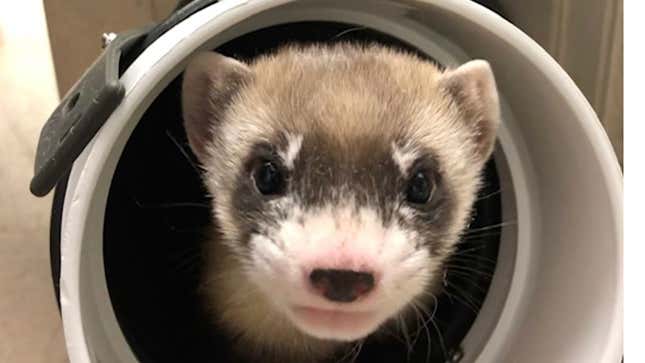
Elizabeth Ann is the first clone of a black-footed ferret, but more importantly, she’s the first endangered species to be cloned in the United States. Her birth represents an important milestone in the ongoing effort to increase the genetic diversity of this threatened species.
Born on December 10, 2020, Elizabeth Ann is the genetic twin of a black-footed ferret named Willa who died in 1988. The Wyoming Game & Fish Department preserved Willa’s cells at San Diego Zoo Global’s Frozen Zoo, where they were stored in a cryobank for decades.
The Frozen Zoo “was created more than 40 years ago with the hope that it would provide solutions to future conservation challenges,” Oliver Ryder, director of conservation genetics at San Diego Zoo Global, said in a statement. “We are delighted that we have been able to cryobank and, years later, provide viable cell cultures for this groundbreaking project.”

Today, all black-footed ferrets (Mustela nigripes) are descended from just seven animals, which is not good. The species was listed as endangered in the U.S. on March 11, 1967 and was, for a while, thought to be extinct. In 1981, a rancher in Wyoming found a group of black-footed ferrets on his land, the members of which were used to kickstart a captive breeding program. Conservationists have been trying to recover the species ever since, and several reintroduced populations now exist across the country.
In 2008, the U.S. Fish and Wildlife Service concluded a five-year study, finding that “the species remains one of the most endangered mammals in the United States, and continues to warrant endangered status,” adding that extinction is not guaranteed, as “the recovery of the species is within reach.” In 2018, the USFWS issued a permit allowing for cloning research into endangered species. This initiative has now advanced to the next stage, resulting in the birth of Elizabeth Ann.
“Although this research is preliminary, it is the first cloning of a native endangered species in North America, and it provides a promising tool for continued efforts to conserve the black-footed ferret,” said Noreen Walsh, director of the Service’s Mountain-Prairie Region, in the USFWS statement.

In addition to San Diego Zoo Global, the USFWS partnered with Revive & Restore (a wildlife conservation organization), ViaGen Pets & Equine (an animal cloning company), and the Association of Zoos and Aquariums (a not-for-profit focused on conservation).
This cloning experiment is being done to increase the genetic diversity of black-footed ferrets—an achievement that could boost ongoing repopulation efforts. Poor genetic diversity is a sign of inbreeding and a small population, and it can lead to a host of problems, including an increased susceptibility to disease and genetic disorders, a diminished ability to adapt in the wild, and lower fertility rates.
Elizabeth Ann, as a genetic duplicate of Willa, is not related to the Wyoming ferrets found in the 1980s. And indeed, the clone’s genome was found to contain an abundance of unique variations compared to the living population. Should Elizabeth Ann be able to mate and reproduce, it would represent a small but very important step forward.
Elizabeth Ann and her surrogate mother are being kept at the USFWS’s National Black-Footed Ferret Conservation Center in Colorado, where the pair will spend their entire lives, according to the statement.
Increasing the genetic diversity of black-footed ferrets is one thing. Restoring their habitat—giving them a place to live, hunt, and procreate—is another challenge entirely.
“Successful genetic cloning does not diminish the importance of addressing habitat-based threats to the species or the Service’s focus on addressing habitat conservation and management to recover black-footed ferrets,” said Walsh.
To see more pics of Elizabeth Ann and even a couple of videos, head on over to her Flickr album.
Since Dolly the sheep was cloned in 1996, scientists have made big strides in the field. In 2018, researchers in China cloned monkeys for the first time, and other teams are working on “re-clones,” or clones of clones.